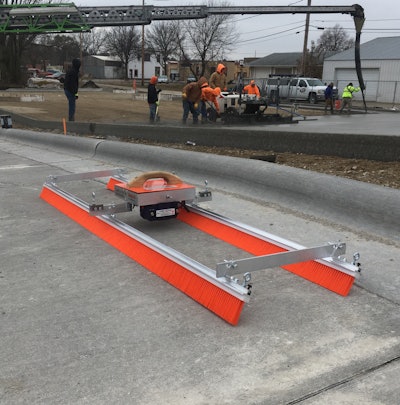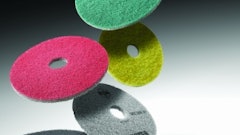
Broom finishes, the most common surface textures for exterior flatwork, are created by pulling a broom over freshly placed concrete. Brooming creates a textured or slip-resistant surface with grooves typically installed crosswise (perpendicular) to the direction of travel. Brooming is performed after floating or troweling and is required for parking slabs and exterior surfaces including slabs, ramps, walkways, driveways, steps and other flatwork requiring a non-slip surface. [1]
In general, there are three broomed finishing categories or more specifically groove depths defined by the American Concrete Institute (ACI) [2]:
- Fine-broomed finish—less than 1/32 in. in depth and created with a soft or horsehair bristle concrete finishing broom.
- Medium-broomed finish—1/32 to 3/64 in. in depth and created with a horsehair or synthetic bristle concrete finishing broom.
- Heavy-broomed finish—3/64 and 1/8 in. in depth and created with a stiff-bristled concrete broom.
While ACI 310R-13 Guide to Decorative Concrete provides the groove depths for fine-, medium- and heavy-broomed finishes, ACI 310R is not a specification and does not provide a means to measure broomed groove depths. Therefore, job owner and architect specifications often vary and can lead to costly disputes. A few general best practices can help contractors avoid these disputes and keep projects on track.
The Basics of Concrete Brooms
Concrete brooms are finishing tools specially designed to install textures to freshly placed flatwork. Common broom widths are 1 1/2, 2, 4, 6, and 8 ft. Brooms are available with and without long handles. A handle-less concrete finishing system (rope brush) is pulled from side to side with ropes instead of being pulled across the surface with a long handle.
Broom bristles typically consist of horsehair or synthetics or blends of horsehair and synthetics to create extra-soft, soft, medium and stiff bristles for installing fine, medium and heavy broom textures. The stiffer the bristles, the deeper the grooves.  Marion's handleless concrete finishing system is pulled from side to side with ropes eliminating excessive handle weight.Marion Brush Manufacturing Co.
Marion's handleless concrete finishing system is pulled from side to side with ropes eliminating excessive handle weight.Marion Brush Manufacturing Co.
Marion Brush Manufacturing Co., which specializes in the manufacturing of concrete finishing equipment, tools and supplies, offers five different textures made from a few key ingredients, which include:
- A smooth, “mendable” resin bristle, which when deformed, Jeff McCaughey, president of Marion Brush Manufacturing Co., says can be brought back to shape simply with boiling water.
- A custom-made resilient brush block that holds up to harsh conditions.
- A high-quality aluminum extrusion backing that McCaughey says allows the finisher to swap out the bristles with up to five different texture refills.
“These options allow the crew to determine which brush stiffness will best achieve the desired texture,” explains McCaughey.
Because of many varying conditions on the slab, McCaughey adds that it is beneficial “to have the ability to swap out textures in order to compensate for unpredictable factors such as changing temps and weather conditions, random shaded areas, or differences in concrete mix itself.”
Some manufacturers color code the bristles according to stiffness so it is easy to select the correct broom for the job. For example, each of Marion Brush’s five textures can be identified by a different color: White Super Soft, Black Soft, Orange Medium, Green Stiff and Red Rough Texture (a stiffness mostly for parking garages, bridge decks, hog lots, etc.)
Groove depths also are a function of timing or how hard the surface is when broomed and downward pressure is placed on the broom. Brooming too early can create deep grooves and an irregular and rough surface; whereas, brooming too late may create very shallow grooves.
Brooming Best Practices
Before brooming, check the surface to determine if the concrete is ready. Use the “finger test” to determine the hardness or readiness of the surface. The finger test consists of pressing a finger on the surface and evaluating the finger imprint depth and surface hardness. Weather and setting characteristics of the concrete are important factors that control concrete stiffening and the proper time to start brooming.
If you start too soon, stop, refloat or retrowel the surface and wait until it has hardened more before retrying. While waiting for the surface to sufficiently harden, protect the surface from rapid moisture loss, especially during windy conditions. Otherwise, plastic shrinkage cracking may occur, and the surface may dry out making it more difficult to achieve an acceptable broom finish.
When the concrete is ready, start by dampening the broom and gently place it on the opposite or far edge of the surface.
“Because bristles absorb some moisture, we have always recommended that finishers initially moisten the bristles with water prior to the first pass,” says McCaughey. “This lubricates the bristles and prepares them for a good initial pass.”
 The adjustable push-pull angled design on Marion's Chamelon Single brush uses the sides of the bristle not the ends to
The adjustable push-pull angled design on Marion's Chamelon Single brush uses the sides of the bristle not the ends to
produce a superior brush finish.Marion Brush Manufacturing Co.
Before each pull, the broom should be dampened but not too wet. If excessively wet or dripping water, brooming can cause surface discolorations, especially with colored concrete. Also, do not wet the concrete prior to brooming because added water can cause discolorations and weaken the surface so it is more susceptible to wear and winter surface scaling. Also, do not broom with bleed water on the surface. If necessary, remove bleed water with a water or compressor hose.
For a more uniform surface appearance, the bristles should be kept clean or free of excessive paste/mortar buildup. After each pull, either shake or wipe a gloved hand along the bristles to knock-off paste/mortar buildup. Bristles can also be frequently rinsed to keep them clean.
McCaughey echoes this advice. He recommends agitating the bristle once each pass is complete and the brush is off the slab by running a gloved hand down the length of the brush to remove excess concrete debris. “This will help to keep all finishing passes more uniform and will decrease the amount of needless rouge debris on the slab,” he adds.
Fresh concrete properties, including slump and setting characteristics, vary from one truckload of concrete to another. Exercise caution when brooming where two truckloads of concrete meet; otherwise, groove depths and broom texture may differ.
Final Appearance May Vary
Concrete groove depths, broom texture and appearance will vary depending on batch variations between truckloads of concrete and different and changing weather conditions, including wind, sun, relative humidity and solar intensity (cloudy or sunny), which affect the setting and hardening characteristics of the concrete. Groove depths vary due to bristle type and downward pressure of broom, wetness of the broom and timing. Even the time of day or the position of the sun affects the appearance of a broomed surface due to changes in light refraction, especially integral colored concrete.
Additionally, the appearance of broomed surfaces will change with time, especially from the initial appearance as surface wear occurs due to both construction and service traffic. For these reasons, the appearance of broomed surfaces will not be uniform but will vary with groove depths and textures, color variations, surface wear and position of the sun when viewed.
Specification Phrases to Avoid
Proceed with caution if your specifications contain phrases such as “coordinate required finish with architect,” “uniform, fine-line texture,” “coarse transverse scored texture,” or “consistent appearance.” The following phrases are also typical broom finish specifications that can lead to disputes:
Immediately after float finishing, slightly roughen trafficked surface by brooming with fiber-bristle broom perpendicular to main traffic route. Coordinate required final finish with the architect before application.
Medium-to-fine-texture broom finish: Draw a soft-bristle broom across float-finished concrete surface, perpendicular to line of traffic, to provide a uniform, fine-line texture.
Medium-to-coarse-textured broom finish: Provide a coarse finish by striating float-finished concrete surface 1/16- to 1/8-in. deep with a stiff-bristled broom, perpendicular to line of traffic.
Immediately after concrete has received a float finish, give the concrete surface a coarse transverse scored texture by drawing a broom or burlap belt across the surface.
Broom concrete surface with a steel or fiber broom to produce corrugations between 1/16- and 1/8-in. deep. Broom perpendicular to nearest edge of pavement. Broom all areas of a panel in the same direction. Use the same type and manufacture of broom for all paved surfaces to provide a consistent appearance.
These phrases do not describe measurable standards and are subject to different interpretation by various parties. The words “coordinate,” “uniform” and “consistent” are subjective and typically interpreted to mean “to the satisfaction of the architect.” [3] Unfortunately, these types of phrases are subjective, ambiguous and sometimes abused by the architect and owner to reject work or hold your retainage.
For the phrase “striating float-finished concrete surface 1/16- to 1/8-in. deep,” it is uncommon to measure groove depths and no standard exists for measuring striation or groove depths of a broom finish. Therefore, even this phrase can be subjective and create disputes between different parties. These types of phrases make it difficult to decide what is being specified and how to bid the specified broom finish. When in doubt as to what the specifier wants, consider clarifying your bid and submit requests for information before placing concrete.
Mockups Minimize Disputes
If properly done, mockups of broom finishes can help minimize costly disputes between contractors, owners and architects. Mockups should represent the actual broom finish achievable for the project and reflect the various variables that affect the final appearance of broomed surfaces. A broom finish installed on a 10 ft. x 10 ft. mockup will not reflect the surface and appearance variations caused by batch to batch concrete variations and different and changing weather conditions. Nor will a mockup reflect the different brooming techniques required for a small-scale versus a large-scale concrete placement.
Therefore, careful planning and execution is required to create a mockup that accurately represents what can be achieved during large-scale concrete placements. Also, submit each concrete placement for acceptance as soon as possible as the work progresses to avoid a finishing dispute for the entire project after the work has been completed.
Kim Basham is president of KB Engineering LLC, which provides engineering and scientific services to the concrete industry. Basham also teaches seminars and workshops dealing with all aspects of concrete technology, construction and troubleshooting. He can be reached at [email protected].
[1] ACI 301-16 Specifications for Structural Concrete, American Concrete Institute, www.concrete.org
[2] ACI 310R-13 Guide to Decorative Concrete, American Concrete Institute, www.concrete.org
[3] Suprenant, B. A. PhD, PE, FACI and Salzono, F., PE, “Specifying broomed exterior concrete surfaces,” Construction Specifier, March 2015, www.constructionspecifier.com


























